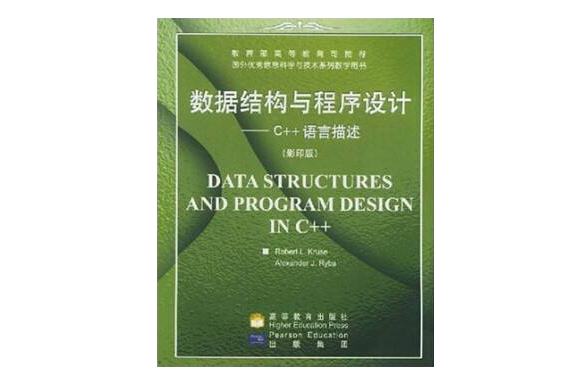《數據結構與程式設計:C++語言描述》是一本正文語種為簡體中文的書籍。
基本介紹
- 中文名:數據結構與程式設計:C++語言描述
- 外文名:Data Structures and Program Design in C++
- 出版社: 高等教育出版社
- 正文語種:英語
- 開本:16
- 編者:克魯斯
- 出版時間:2001年5月1日
- 頁數:717頁
- 裝幀:平裝
- 正文語種: 英語
- ISBN: 9787040100396

《數據結構與程式設計:C++語言描述》是一本正文語種為簡體中文的書籍。
《數據結構與程式設計:C++語言描述》是一本正文語種為簡體中文的書籍。...... 《數據結構與程式設計:C++語言描述》是一本正文語種為簡體中文的書籍。 [1] ...
本書涵蓋了“數據結構與算法”的核心知識單元,使用C++語言描述。書中不僅系統介紹了各種傳統的數據結構和搜尋、排序算法,還引入了比較高級的數據結構,如伸展樹和跳表...
C++是C語言的繼承,它既可以進行C語言的過程化程式設計,又可以進行以抽象數據類型為特點的基於對象的程式設計,還可以進行以繼承和多態為特點的面向對象的程式設計。...
數據結構課程設計:C++語言描述,本書是配套課程設計書,它不但根據教材的相應章節設計,而且還給出了每一個章節的重點和難點、還有些典型例題和實驗解答。...
《數據結構C++語言描述》是2004年作/譯者朱戰立出版社出版的圖書,作者是朱戰立。...... 數據結構C++語言描述圖書目錄: 編輯 第0章C++程式設計基礎0.1程式的結構...
《數據結構:使用C++語言描述》是一本正文語種為簡體中文的書籍。...... 《數據結構:使用C++語言描述》是一本正文語種...1.4 C++程式設計1.5 數據結構的描述1.6 算法...
《數據結構使用C++語言描述》是2008年人民郵電出版社出版的圖書,作者是陳慧南。本書保留經典數據結構知識,引入伸展樹和跳表等新內容,教材反映抽象、封裝和信息隱蔽等...
《數據結構(C++描述)》是2011年人民郵電出版社出版的圖書,作者是胡學鋼,張晶。...加強算法和程式設計的分析,引導和加深學生對技術的理解;以通俗的語言講解內容,...
圖書簡介本書是一本非常暢銷的數據結構基礎教材的第2版,它使用標準ANSIC和C++程式設計語言來實現數據結構。我們通過大量實際的問題演示了如何套用C和C++程式來實現...
《數據結構、算法與套用:C++語言描述 》是2000年機械工業出版社出版的圖書,作者是Sartaj Sahni。該圖書在簡要回顧了基本的C++ 程式設計概念的基礎上,全面系統地介紹...
《數據結構(C++語言描述)》是1997年清華大學出版社出版的圖書,作者是福特等。...... 內容從數據結構的基本原理到面向對象程式設計的方法。書內使用適應面極廣的C++...
《數據結構與算法分析:C++語言描述》是2006年11月1日清華大學出版社出版的圖書,作者是(美)奈霍夫。...
《C++數據結構與程式設計》是2004年由清華大學出版社出版的圖書,作者為克魯斯。...... 《C++數據結構與程式設計》是2004年由清華大學出版社出版的圖書,作者為克魯斯...
《數據結構與算法分析——C++語言描述(第2版)》是2014年清華大學出版社出版的圖書,作者是Larry Nyhoff。...
《數據結構與算法:C 語言描述》是一本正文語種為簡體中文的書籍。...... 《數據結構與算法:C++語言描述》根據作者多...與算法的很好示例,也是很好的C++程式設計示例...
《數據結構——使用C++語言描述》是2008年出版的圖書,作者是陳慧南。...... 《數據結構——使用C++語言描述》是2008年...本書重視程式設計和實踐性。書中算法都有...
《數據結構:使用C++語言》是一本正文語種為簡體中文的書籍。...... 討論各種數據結構的設計和套用問題,用C++語言描述和實現了20多個類的設計和典型套用問題的程式...
《數據結構與面向對象程式設計(C++版)(第4版)》是2012年清華大學出版社出版的圖書,作者是Michael Main、Walter Savitch。...
《用C++實現數據結構程式設計》是2019年清華大學出版社出版的圖書,作者是馬春江。...... 《用C++實現數據結構程式設計》是2019年清華大學出版社出版的圖書,作者是馬...
C++是C語言的繼承,它既可以進行C語言的過程化程式設計,又可以進行以抽象數據類型為特點的基於對象的程式設計,還可以進行以繼承和多態為特點的面向對象的程式設計。...
《數據結構--C++語言描述》是一本書籍,高等教育出版社出版,作者朱戰立。...... 數據結構--C++語言描述圖書目錄 編輯 第0章C++程式設計基礎0.1程式的結構...
《算法設計與分析:C++語言描述》是2006年5月1日電子工業出版社出版的圖書,作者是陳慧南。...
《算法設計與分析:C++語言描述(第2版)》於2012年7月出版,作譯者陳慧南。這本書主要分為3部分:算法和算法分析、算法設計策略及求解困難問題,還介紹了兩種新的數據...
本書以面向對象觀點討論各種數據結構的設計和套用問題,用C++語言描述和實現了20多個類的設計和典型套用問題的程式設計。本書討論的典型數據結構包括:線性表、堆疊、...
C++程式設計與數據結構基礎教程於2006-9出版。...... 本書由三部分組成:第一部分介紹C++程式設計語言的基本成分,詳細闡明了使用C++進行面向過程的結構化程式設計方法...
數據結構(C++語言版)(第3版)內容簡介 編輯 《清華大學計算機系列教材:數據結構(C 語言版)(第3版)》按照面向對象程式設計的思想,根據作者多年的教學積累,系統地...
《現代程式設計:C++與數據結構面向對象的方法與實現》是2002年北京理工大學出版社出版的圖書,作者是沈晴霓,聶青,蘇京霞。...
本書系統地介紹了各種典型的數據結構,主要包括線性表、棧和佇列、串、數組和...對算法和C++語言的理解,還介紹了算法及算法分析、面向對象的程式設計與C++方面的...
